
|
Lorna Mills and Sally McKay
Digital Media Tree this blog's archive OVVLvverk Lorna Mills: Artworks / Persona Volare / contact Sally McKay: GIFS / cv and contact |
View current page
...more recent posts
 | 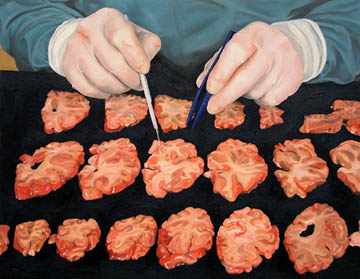 |
|
Art meets science in Damien Hirst's new show at Gagosian in New York, which I haven't seen. The image on the left is the original photo, the right is Hirst's painting (painted by a roster of assistants with some input from Hirst himself.) A press release at Science Photo Library says: "The paintings signal a new direction in [Hirst's] work - that of photorealism. Photorealism was an invention of the 1960s. Take a photograph, and copy it meticulously, until your painting and the photograph are indistinguishable. From a distance Hirst's paintings look like photographs. But close up you can see that they have all been executed using oil paint and brushes." ...and... "We do occasionally licence our images to artists who want to use them for source material. But until you see the finished artwork, we never know how close to the original photograph it will be. The look and feel of the Hirst's oil paintings is different from the original photographs, although the image itself is almost facsimile reproduction." Michael Kimmelman said in NY Times (available here) "[Hirst's paintings] arrive amid a booming youth market, as shallow and money-obsessed as Mr. Hirst, and just as enamored of fashion, but with a higher premium placed on solo handicraft and earnestness or at least on the appearance of it." David Cohen at artcritical.com says: "If you want to see Mr. Hirst’s careeer in terms of iconoclasm, you could say that by producing 31 dutiful, soporific canvases he has delivered a fatal overdose to painting more decisive than the assassination attempt of his pickled shark. But Mr. Hirst isn’t really an iconoclast. For all his razzmatazz and buffoonery, he is in deadly earnest about the power of images." | |
I've been invited to do a guest questionnaire over at Simpleposie. Survey's up!
Welcome to Clog, a cut below the average blog

Well, it has to happen soon or later, former guest poster Joester has started a blog of his own. Don't miss his inaugural post on the "sometimes snack" and spirituality bracelets.
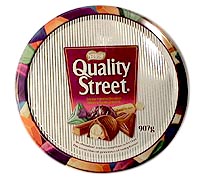
Thanks to everyone who came out to the Qualia Street Closing Party and Von Bark Lecture last night. It was fun fun fun. You guys are great. Also apologies... I forgot to bring down the very important candies! After we made a special trip to the Bay and everything. Next time.
 |  |
here's my one-line-list review of "What the Bleep Do We Know." (thanks to Joester for the idea)
- More gratuitous graphic cheeze than Brian Greene's PBS wank-doc on string theory.
- I wish they would've told us up front that the blond pundit was channelling somebody else.
- This film had as much integrity as a chiropractor talking about how the uncertainty principle means you can change reality with your mind.
- I learned that a lot of basketballs is a "field" whereas just one basketball is a "particle."
- I would've found the extended wedding party dance interlude with cute animated characters representing human cells under the chemical influence of love extremely tedious, but I stopped watching at that point and skipped to the final credits, which was the first place any of the so called "experts" who'd been spouting off all movie were identified on screen.
I very much enjoyed Doug Saunders' column in Saturday's Globe and Mail (only available w/paid online subscription), "Longing for something authentic? Watch your step." In Rome, he visited the Italian home of Massimo, a "charming and eccentric man who lives at the centre of one of Italy's more vibrant intellectual cultures." Says Saunders:
In this world of hybrids, fakes, phonies, knockoffs and massproduced corporate clones, it is a thrill to run into somebody who is undeniably authentic. [...] People have had enough of noisy music composed of machine-made samples; instead they want a CD of pure, true native folk music or genuine keep it real ghetto authenticity. They want to avoid drugs and doctors and hospitals and deliver their children at home in good grubby medieval agony. They like books with simple, genuine narratives and none of that clever, academic wordplay. They want the good old politics of nationalisim, maple leaf flags and Crown corporations, even if it meands keeping the Queen on the money. At least its real.Says Massimo, showing off his collection of art and artifacts from around the world:
Unfortunately, there aren't many people left who are interested in tradition. The Ango-American world is flattening every alternative culture with its globalization. Being a minority, I identify with the American Indians, with the Irish, with the Muslims everywhere. This is what I have been writing about for decades.And, showing off his bust of Mussolini:
It was our greatest moment. We have to build a new future in its image, but it's not going to happen like that again. [...] I'm not against other cultures or immigration, I'm just against the mixing of races. That is a constant value: authenticity, purity. I don't mind being called a facist, and for all my life I have been proud of my facist heritage. But if we are ever to win again, we will have to call it something different. It will not happen until we are a real, genuine people.Yike! Good one Doug. I've been tilting at windmills lately, irritating my friends by worrying about fascist-looking art. All of a sudden, aspects of an artist like, for instance, Istvan Kantor bother me, where in the past I would've been simply irritated or ambivalent. I recently saw a screening of Kantor's super8 film "Fish Head," in which he guts a live fish and wears it on his shaven head, like a centurion's helmet. The fish is still swishing its tail and gulping, blood runs down Kantor's cheeks. The image is iconic, and visually satisfying. It got under my skin and I can't stop mulling it over. (Does this mean its good art? - damn!) I'm not too concerned for the torture of this particular fish (I eat fish after all, and have been fishing once or twice), but rather what invocation of power rises off the scene. Granted, the film is from a long time ago (mid-80s?), and it seems to me that in the context of pre-millenial post-modernism, the punk-rock nihilism of quoting fascism was kind of sexy/quirky (a la Attila Richard Lucas), connected to fetish and individual expression more than to past political movements of oppression. But nowadays, in the wake of USA's disregard for NATO, Guantanamo Bay, the insidious erosion of human rights such as the current persecution of Times Up in New York, and the outrageous psy-ops of homeland terror alerts, I'm finding such acts and images a lot more creepy.
 |  |  |  |  |  |  |  |
 |  |  |  |  |  |  |  |
 |  |  |  |  |  |  |  |
 |  |  |  |  |  |  |  |
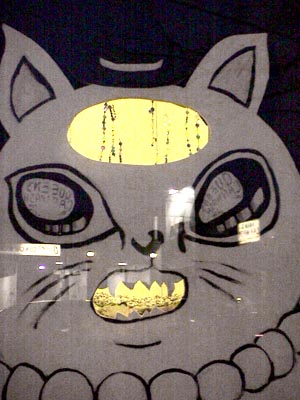 | Qualia Street Closing Party and Von Bark Lecture Fly Gallery party at Saigon Flower 1138 Queen St West NEXT WEEK: Wednesday, April 27 8:00 pm My art installation at Fly Gallery (1172 Queen St. W) is up until the end of April. Come celebrate the closing with us on April 27th at Saigon Flower. Arrive at 8:00pm for Von Bark's lecture on Vermillion Qualia and the Mind/Body Split (or something like that), stay for drinks and fun. Yes, there will be party favours. Pop down the block and check out the window display one last time (best viewed after dark). |
| Qualia is defined as, "the subjective qualities of conscious experience (plural of the Latin singular quale). Examples are the way sugar tastes, the way vermillion looks, the way coffee smells, the way a cat's purr sounds, the way it feels to stub your toe." Excerpt from The Oxford Companion to Philosophy, Oxford University Press, 1995. | |
 | |
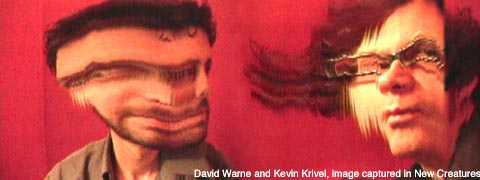
On Saturday I went to a presentation by artists Kevin Krivel and David Warne, in collaboration with Greg Hermanovic, at Trinity Square Video. The trio had constructed a pretty cool new-media installation called New Creatures that shoots video portraits, stacking instances into one image so you can scroll through a captured motion in real time. One side captured head shots and the other captured full body movement. It was fun to play with and the images were sometime beautiful and sometimes creepy. Neato! Both Warne and Krivel come from architecture backgrounds, and Hermanovic is a special effects software developer. The collapse of art, architecture, and design opens doors for all kinds of thought and production, but it also seems to generate hyperbole. Here are some choice quotes from the presentation:
About a projection in an elevator: "We were exposing the verticalness of the shaft." About funky video footage synched to a musical beat in real time: "It's a synthesis of sound and vision." About an installation in which furniture was wired to trigger video projections when manipulated: "Objects continue to be places where there is a physical engagedness."Hermanovic's company, Derivative, makes a software product, called "Touch" that is genuinely very cool, allowing you to mix and manipulate video in real time. It's useful for vjs and concerts (Derivative did displays for last summer's Rush tour). But the package comes with a whole palette of ready-to-go clips that as Hermanovic said, are "pre-authored, and the user performs them." The imagery is catchy, fashionable, and vapid.

images available in Derivative's online media kit
During this presentation I started feeling inklings of despair at distopic visions of the art/culture sector meshing inextricably with commodity and product design. I was jolted from my nega-reverie by the phrase, "This one is for you Queen Street types." It was a pre-authored clip called "Toronto Appliances," featuring Queen Street storefronts, and one in particular that had just closed down near the Drake Hotel.
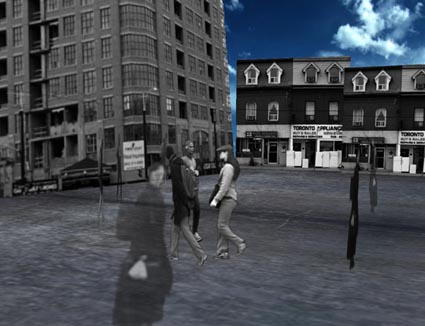
Toronto Appliances, pre-authored video by Derivative.
Back in 2003 the last issue of Lola publised a story about the then-under-construction hipster hot-spot, the Drake Hotel. (For those readers who don't know Toronto, the context is a formerly somewhat run-down area of town, populated by lower income tenants and lots of artists, which started filling up with galleries, which quickly led to condos, bistros, fancy knick-knack stores and tapas bars for people from other neighbourhhoods who drive fancy cars. You all know the story, cause it happens in every town.) Anyhow. In this issue of Lola a gallerist in the area was quoted about the development of the Drake, saying, "If they provide good service and good hospitality, it will attract people to the area and hopefully that will move out some of the used appliance stores." Ouch.
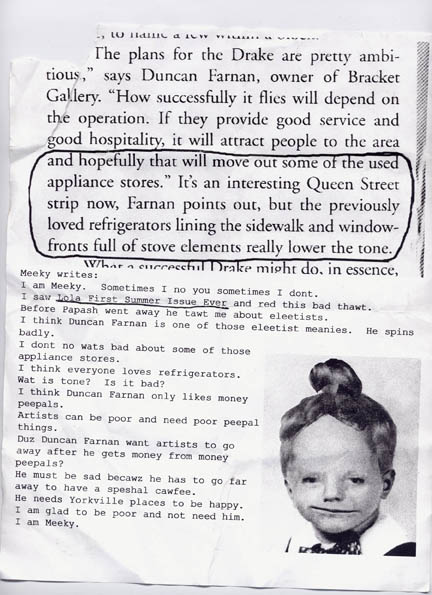
After the magazine came out, these posters appeared, calling the gallerist an "eleetist meanie." (Thanks to Tanya Read, who collected and scanned this copy.) I dunno who Meeky is, but I'm sure glad he/she made some fuss. I know that I tend to be a stick-in-the-mud. I know that urban demographic shifts are inevitable. I know that the institutions of fine art ride on the financial coat-tails of empty-headed culture-tainment. All this makes me crabby, complicit, and confused. I don't drive a fancy car, nor live in a fancy condo, but I do occasionally drink fancy drinks and eat fancy food in fancy bars with my both my fancy and my not-so-fancy friends. And, of course, I have my own art display up on Queen Street West right now. Its at Fly gallery, with whom I am more impressed every day. They remain a tiny bastion of level-headed art sanity, standing firm in the midst of the crazy high-brow/low-brow maelstrom that swirls around their block.
A little while ago I posted a picture from the Haida blockade on the Queen Charlotte Islands. There is a solidarity demonstration in Toronto this week. Here's the scoop for anyone who is interested:
Haida Solidarity Demo Against Weyerhauser
Support the Haida Nation Blockades
Thursday April 21, 5:30 p.m.
130 King St. West
Northeast corner of King and York Streets
(One block East of St. Andrew subway station)
Contact: David at dsone@ran.org
Check out: www.haidanation.ca
Come out and show that we stand with the Haida and their demands for self-determination, Native rights, ancient forests, and sustainable local economies.
While Weyerhaeuser holds their Annual Shareholder Meeting in Seattle, let's join people in Haida Gwaii, Seattle, Vancouver, New York and Winnipeg to help show investors and customers that Weyerhaeuser is an unethical and unsafe corporate criminal.
(continued...)
Schwarz is looking for recommendations on tunes from this collection of old Canadian gramaphone recordings from the National Library and Archives site. It's massive! who knew?

Ratzinger.
(no fucking comment)
(fuck)
Mary Midgley on metaphor (as used/abused by scientists):
To understand how metaphors can properly be used in scientific writing, we must get straight a fundamental point about the relation between metaphors and models. Every metaphor suggests a model; indeed, a model is itself a metaphor, but one which has been carefully pruned. Certain branches of it are safe; others are not, and it is the first business of somebody who proposes a new model to make this distinction clear. Once this is done, the unusable parts of the original metaphor must be sharply avoided; it is no longer legitimate to use them simply as stylistic devices. For instance, the familiar model of mechanisms in biology has long ago been pruned of its original implication that a mechanism needs an inventor or maker. Anyone writing about a ‘biological mechanism’ knows that he must keep such inventors out of his explanation. He must somehow manage to use the language of purpose and adaptation without this reference; figurative speculations about the inventor’s character and history will damage and confuse his reasoning. He may want to do theology, but if so, he must do it explicitly, not by loosely extending the language of ‘mechanisms'.Vilayanur S Ramachandran on metaphor (as related to synesthesia):
...one of the odd facts about synesthesia which been known for a long time and again been ignored, is the fact that synesthesia is much more common among artists, poets, novelists, you know flaky types! So now why is it much more common? Well one view is that - in fact according to one study it's seven times more common among artists poets and novelists and the reason is what do artists, poets and novelists all have in common? Just think about it. What they all have in common is they're very good at metaphor, namely linking seemingly unrelated concepts in their brain, such as if you say "out out brief candle", so it's life, why do you call it a candle? Is it because life is like a long white thing? Obviously not. You don't take the metaphor literally, although schizophrenics do and we won't go into that. So why do you that? Well it's brief like a candle, it can be snuffed out like a candle, it illumines like a candle very briefly. Your brain makes all the right links and Shakespeare of course was a master of doing this. Now imagine one further assumption - if this gene is expressed more diffusely instead of being just expressed in the fusiform or in the angular, if it's expressed in the fusiform you get a lower synesthete, in the angular gyrus TPO junction you get a higher synesthete. If it's expressed everywhere you get greater hyperconnectivity throughout the brain making you more prone to metaphor, links seemingly unrelated things because after all concepts are also represented in brain maps. This may be seem counter-intuitive but after all a number, there's nothing more abstract than a number. You can have five pigs, five donkeys, five chairs - it's fiveness - and that's represented in a fairly small region namely the angular gyrus so it's possible that concepts are also represented in brain maps and these people have excess connections so they can make these associations much more fluidly and effortlessly than all of us less-gifted people.

I had a stomach-dropping sensation when I walked into YYZ Artists' Outlet and first saw Christopher Flower's installation because the video of shaking beads looked JUST LIKE some of my video of shaking beads which has not yet been shown. Only his looks better. And he also has a cat in box. Arg. But I figure its a big world and there's room for more than one artist to make images relating to physics and philosophy using shaking beads and cats in boxes...right? heh. Anyhow, once I got over the professional jealousy hurdle I started to really enjoy the work. There are more things shaking than cats and beads, also bagels, beer bottles, soccer balls, goldfish, and other sundry items. The installation is called The Cave, which makes tons of sense, as these objects and the patterns they make are both everyday and mysterious, un-revealing like shadows on a wall. Three monitors display three different scenes, each always a container with something bouncing around inside. I don't know how he achieved the effect, as the boxes and bowls are static, while the stuff inside is clearly bouncing and jouncing as it is being vigorously shaken. As you stand there for awhile, the accumulative effect of watching these items zoom around under unseen forces gets pretty spooky. But nothing is really hidden, you can hear the sounds of shaking, and everything has a nice clunky table-top feel. Flower cites the influence of Der Lauf Der Dinge by the artist team Peter Fischli and David Weiss (nice little trailer available here). The connection makes lots of sense, as both works share the gawky-get-somehow-thrilling dichotomies of banal/sublime, mechanical/alchemical, science/magic, experiment/performance, all handled with clumsy/finesse and DIY/expertise. The show is on til May 21st. If you are the least bit nerdy, go see it.

Omigod I love Wikipedia. Somebody uploaded this gorgeous gif of their own MRI scan.
Here's some more nice brains:
 |
 |
 |  |
Listening to Vilayanur S Ramachandran has got me looking for pictures of grey matter. His lecture on art, that I quoted earlier, was okay, but his stuff on "self" and his bizarre case studies (a la Oliver Sacks) are fabulous. He's extreme in his physiological outlook. Here's a quote:
What exactly do people mean when they speak of the self? Its defining characteristics are fourfold. First of all, continuity. You've a sense of time, a sense of past, a sense of future. There seems to be a thread running through your personality, through your mind. Second, closely related is the idea of unity or coherence of self. In spite of the diversity of sensory experiences, memories, beliefs and thoughts, you experience yourself as one person, as a unity.
So there's continuity, there's unity. And then there's the sense of embodiment or ownership - yourself as anchored to your body. And fourth is a sense of agency, what we call free will, your sense of being in charge of your own destiny. I moved my finger.
Now as we've seen in my lectures so far, these different aspects of self can be differentially disturbed in brain disease, which leads me to believe that the self really isn't one thing, but many. Just like love or happiness, we have one word but it's actually lumping together many different phenomena. For example, if I stimulate your right parietal cortex with an electrode (you're conscious and awake) you will momentarily feel that you are floating near the ceiling watching your own body down below. You have an out-of-the-body experience. The embodiment of self is abandoned. One of the axiomatic foundations of your Self is temporarily abandoned. And this is true of each of those aspects of self I was talking about. They can be selectively affected in brain disease.


Best bad joke award goes to Kevin Radigan. The third year OCAD sculpture student proved that just one person can create massive change...(heh). His installation of giant arrow and nickels is a welcome intervention on the AGO's "Massive Change" signage (which I already complained about here). While I was down there today taking pictures, passersby were laughing and stopping to chat. Lots of media interest too, and apparently the AGO are talking about making the installation permanent. I guess everyone is getting pretty sick of that big friggin sign!
 | 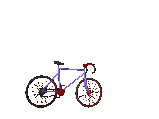 |  |  |  | |
 |  |  | |||
Thanks Tino, for the link to bike gifs!

Neurologist Vilayanur S Ramachandran on art (from BBC Reith Lectures 2003 online) (thanks to Marc Ngui):
Let's assume that 90% of the variance you see in art is driven by cultural diversity or - more cynically - by just the auctioneer's hammer, and only 10% by universal laws that are common to all brains. The culturally driven 90% is what most people already study - it's called art history. As a scientist what I am interested in is the 10% that is universal - not in the endless variations imposed by cultures. The advantage that I and other scientists have today is that unlike we can now test our conjectures by directly studying the brain empirically. There's even a new name for this discipline. My colleague Semir Zeki calls it Neuro-aesthetics - just to annoy the philosophers.Ramachandran's 10 universal laws of art:
- Peak shift
- Grouping
- Contrast
- Isolation
- Perception problem solving
- Symmetry
- Abhorrence of coincidence/generic viewpoint
- Repetition, rhythm and orderliness
- Balance
- Metaphor
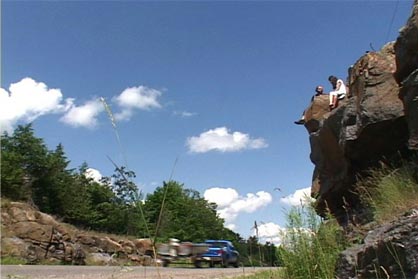
G.L.N., Space Ship Earth: Highway 44, 2004. From the Power Plant website
I was recently in conversation with a group of artists, all of whom were upset about Sarah Milroy's Globe and Mail review of the current Power Plant show, Dedicated to you, but you weren't listening. Having neither seen the show, nor read the review, I kept my mouth shut except to ask, "Did you disagree with her?" The answer I got was indirect, "She acted irresponsibly when she trashed the younger, local artists." This is a normal, almost commonsense point of view, but it kind of bugs me. Wouldn't it be more irresponsible for a journalist to hold her tongue, and refrain from calling it as she sees it? Art writing is hard, all the community pressure on a writer is towards promotion, while the editorial pressure is towards sensationalism and "news." I respect Milroy for sticking to her own path and if she errs on the side of crabby rather than chummy I'm all for it. All that said, I sometimes disagree with Milroy's point of view. So I went to see the show for myself.
I was impressed with the low-key metaphysics, ambition and transcendence, with a minimum of sensationalism. Two pieces were particular highlights for me, "Space Ship Earth" by G.L.N. (Maura Doyle and Tony Romano) and "Returning a Sound" by Jennifer Allora and Guillermo Calzadilla. "Space Ship Earth" will appeal to anyone who has ever identified with David Bowie's character in The Man Who Fell to Earth. With disorienting Nicholas Roeg-style camera, the two artists set up durational shots in which they play spooky ambient music in outdoor environments, recording the indigenous sound and re-inserting it into the mix. Cars whizzing past are re-cast with technological humming undertones, blue jays cries are repeated, wind and water are amplified. Sun and shadow play subtle visual games, casting grasses and rocks as the visual protagonists, throwing the environment, and by extension the planet, into surreal relief. In one sequence, an agitated black cat prowls in front of the camera, often blocking the view entirely. In another the artists and their gear are hidden in a meadow of tall grasses and wildflowers that fill the screen. In my favourite sequence, they sit perched high on a rock by the highway, the passing cars like space ships or weird animals, the clouds above suspended like space ships or weird animals in a perfect blue sky.
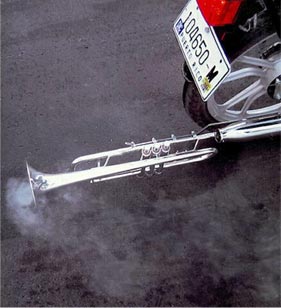
Jennifer Allora & Guillermo Calzadilla, Returning a Sound, 2004.
From the Power Plant website
In Jennifer Allora and Guillermo Calzadilla's "Returning a Sound" a young man rides a scooter with a trumpet attached to his tailpipe. This produces a remarkable compelling tone, that shifts range and volume as he revs the engine. Chin held high, the guy zooms past buildings, beaches, enormous trees dropping flowers and lush green fields, the trumpet ringing out a surprisingly muscial call. He is riding around his home on Vieques — an island off Puerto Rico — which was used by US military as a bombing test site for 60 years. The piece is an eloquent but undidactic testament to the work of local protestors who eventually managed to reclaim their land.
Another notable piece was "Open Access," a doorway cut into the west wall by artists Julio Castro, Gabriel Cazares and Roland Flores. The door swings open, providing free gallery access to anyone who wanders in. Dan Graham's "Opposing Mirrors and Video Monitors on Time Delay," was an optical adventure in disorientation, but we expect nothing less. Dave Allen's charismatic starlings have tons of personality — and they look happy in their gigantic cage — although the idea that they might begin to vocally mimic the musical compositions that are being played for them seems somewhat incidental to the novelty of looking at starlings as if they were precious and interesting creatures (they do have beautiful plumage, as a matter of fact, and a plucky urbane style).
All the works involve some form of collaboration. According to curator Reid Shier, the show poses the question, "What is the nature of authorship when multiple, perhaps contradictory, voices are invited to come together in the production of a work?" Zin Taylor's strange non-collaboration with Japanese musician Aki Tsuyuko is a case in point. Never having met Tsuyuko, Taylor made a video inspired by her music. His video is an exploration of dirt piles in extreme close up, the image breaking down into buzzing video dust in darkest shadows. The camera slowly pans by gaping holes, weird orifices in the dirt. In an accompanying booklet, correspondence between Taylor and Tsuyuko reveals that the musician is mystified, unimpressed and possibly slightly insulted by Taylor's interpretation of her music. The piece is poignant, Taylor stretches for something ineffable in the video, then sends his art across the world, and fails to make a meaningful connection. In this climate of hegemony and global trade, its an unexpected surprise.
In the light of current draconian attitudes to community postering, Derek Sullivan's "Endless Kiosk" should be a beautiful urban gesture. Placed in the public foyer outside the gallery, the piece is a pole that people can use to put up notices, art, refuse, love-letters, or whatever other paper products they'd like to share with other passersby (a fresh bucket of wheat paste is provided). Unfortunately, the area is not a functional public commons. People come to Harbourfront for specific events, usually in cars, and then leave again. They rarely linger, but when they do mingle they are strategically schmoozing and posing, not shamelessly posting promotion. The pole's offer of a public forum is so-far un-exploited, and the piece seems forlorn.
*************************************************
After writing the above paragraphs, I read Sarah Milroy's review and found that indeed, we mostly disagree. G.L.N.'s "Spaceship Earth" was by far my favourite piece, striking a deep and resonant chord, while she suggests these artists are "fiddling around on the margins." I felt that Johnathan Monk's "Searching for the Centre of a Piece of A4 Paper" was an empty, art-joke gesture, while for her it evoked "two dragonflies mating in midair, never quite achieving a resting point of consensus." Milroy's overall take on the show was negative and she ends her piece with a kicker: "These are wry, miniature epiphanies, offered up half-heartedly to the world, not quite witty or inventive enough to evoke Duchamp." Perhaps I'm just more partial to conceptual art, but overall I found the show engaging and profound. Its a good thing, though, that writers have different points of view. I don't think Milroy was gratuitously mean in her critiques, and she gave the whole show careful atttention. In my review, I left out the works that did not mean much to me, rather than digging in to criticize. Does the fact that I am an artist as well as a writer make me too chicken of my colleague's feelings, and therefore unable to be properly critical? I hope not. I'm not normally squeamish about stating my opinions. But I do make a conscious attempt to say something generative if I am going to say anything at all, and I know the boundary between being positively oriented and being scared to say "boo" is one that requires vigilance. For that reason I respect and appreciate Milroy's role as an art critic in this town, and I am glad she does not coddle the local youngsters when she truly doesn't like what they are doing.
Matthew Collings had a great article in the March issue of Art Review trashing the movie Modigliani along with Lust for Life, Pollock, and other films that represent artists in the "debased romantic tradition of the sentimental tortured charming impossible boy-man" Here's more:
Anyone used to looking at painting and having an understanding of what its about in historical terms and as a crafted object can see immediately that the art in Modigliani, which is all inept in the same way, is a mess, incoherent bundles of signs that say 'Modern Art'. But at the same time this pseudo-art is ambitious in a horrible way. Its statement is 'I am impressive. Look at me'; not 'I am the result of a ceratin type of serious endeavour, involving both the past and the present, in which the artist as a man takes a back seast in terms of ego and pride — that kind of thing simply doesn't help make forms cohere and colours harmonise; so basically you've got to knock it on the head if you want to be any good.' Instead we get something truly base. A supposedly great masterpiece by Picasso is unveiled amidst a lot of hoopla, everyone gasps at the audacity, the genius, etc, while 'Picasso' does a little proud, moved, humble but also arrogant smile, as if to acknowledge, 'Yes, I am the sex and art king of all time, but I also concede I owe my greatness to a long line of geniuses going back to Raphael, whom I listen to over my shoulder while working in my atelier!' That is, a part truth — Picasso's indebtedness to history and tradition — becomes a whole lie: art is for social climbing, for intimidating the other guy.
The next show at MOCCA (opening Saturday) is going to be good. Donigan Cumming is a strange cat who makes strange videos. Peggy Gale guest curated the exhibition. Gale herself has an interesting story. She's been Canada's expert on video art pretty much since the medium was invented. In the early seventies she curated a comprehensive cross-Canada show at the AGO called Videoscape. Back then, video art tended to be conceptual and performative, exploring the possibilities of real-time and the seeming physicality of video itself. Said Gale in her 1977 essay for Parachute, "[Video] is not 'over there,' projected away from us onto a wall or screen as is the case with film. Rather it is 'here;' it projects it's message from within, as would a person who is interacting directly with us. As such, video has a presence which demands attention."
Video art has come a long way since the single-shot days of the early 70s. No longer a reel of magnetic tape, conceptually tied to television and performance, video has become a diffused-yet-integral component of the contemporary multi-media environment. Gale, with her prevailing interest in narrative and the tangibility of ideas, is still pushing her writing and delivering insights into the medium. Hence a show by Donigan Cumming, who's work is multi-layered and challenging, twisting fiction and documentary together in a tight and disconcerting weave. His works feature people living with poverty, old age, and substance abuse. The viewer is confronted with too much intimacy: the saggy flesh, toothless maws, and abject living conditions of some very down and out people. We are invited to peek into a strange relationship between Cumming and his subjects. He is too close, in fact the narrative of desperation seems to belong to the artist as much as it does to his characters. Is this fiction, document or exploitation? If fiction, why the painfully acute level of realism? If document, why is the artist himself so present in the work?
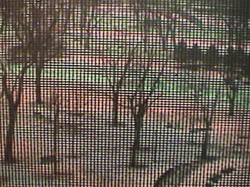
| 
|
Says Gale, "When I was asked to curate this show I felt I could say something that hadn't been said yet. It was very hard to nail it." And nail it she did. The exhibition is accompanied by a vivid publication, more an artists' book than a catalogue, that visually puns with pixels and window screens, nutting around with the contemporary construction of video images while at the same time presenting poignant pictures of sad reality. Gale's essay is elucidatory. Here's a quote:
"The relationships between Cumming and his accomplices are complex. Some have become his friends, and stay in regular touch; others surface only in the photos and video works. These touch on the tradition of "concerned photography" with its probing of issues and personal trauma; the resulting images, however, are far from the beautiful photographs that appear no in photo-journalism, as eloquent, even seductive, studies of famine victims or war zones, inner city violence or environmental decay. Ironically, the gritty realities to which we are introduced in Cumming's work, may not be all that they appear, nor even be honest portraits. Facts conflict. They insist on something other than direct or "true" documentation, despite the profusion of information and nuance that they display. Yet while Cumming's work has been reviled on occasion as obscene—that is, offensive or abhorrent to prevailing concepts of morality or decency—the work is highly moral and engaged, and very far from inciting lust or depravity. Insofar as his images are "offensive" one must look not to the artist's intention but to his departure from the sanitized world of contemporary advertising and so-called lifestyle modes. Sex and violence? Not here. Offensive to the senses, disgusting, loathsome, foul? Only from a certain (blinkered) point of view."
You never saw so much hemming and hawing as me trying to decide whether or not to go see the big Bruce Mau induced design show at the Art Gallery of Ontario, MASSIVE CHANGE. The huge lettering on the outside of the building finally wooed me with their promise of spectacle. Paying the fee to get in proved to be an interesting mistake (the website is comprehensive). I previously had no idea that such totalitarian design concepts had taken hold north of the border. Floor-to-ceiling lettering throughout the exhibition made headline pronouncements such as "We will eradicate poverty....We will build intelligence into materials and liberate form from matter...We will design evolution." The first display is about urbanization. Fast-paced video of high density downtowns and satellite images of the earth is accompanied by a sauve, female voice who makes the unnerving claim that "everywhere is city: We still conceive of cities as discrete objects, separate from their surroundings. This is no longer true. There is no exterior to the global city that connects and sustains us all." The display climaxes with gigantic letters that pronounce:
EVERYWHERE=CITY DESIGN=HOPE
Yike, steady on! Some might still say that DESIGN=DECORATION. Yet for all the obnoxious bluster and posturing of this show, I enjoyed its amibitious attempts at categorization. Like Orbis Sensualium Pictus, Bruce Mau and the Institute Without Boundaries have attempted to depict the entire world. The breakdown (scribbled down from the catalogue table of contents) goes like this:
- Urbanization Economies (eg: density, housing)
- Movement Economies (eg: personal freedom, global movement)
- Energy Economies (eg: clean power)
- Information Economies (eg: Lessig on free culture)
- Image Economies (eg: micro and subatomic photography)
- Market Economies (eg: corporate accountability, ecology)
- Material Economies (eg: super hard, super light, bio mimicry)
- Military Economies (eg: conventional war, virtual war, cyberwar, peace)
- Manufacturing Economies (eg: ecology and equity)
- Living Economies (eg: genome, biomedia, drinking water)
- Wealth & Politics (eg: citizen revolution, digital divide, global poverty, women's health, gender power imbalance)
This is my last post to the main page of Sally's blog. Several weeks ago I booked a flight to a relentlessly Catholic country and I have to leave town soon, plus it will be really hard to get a good wi-fi signal in a gothic cathedral. Thanks to the generous loan of Sally's powerful laboratory microscopes I am able to leave you with this image of the College of Cardinals balancing on the head of a pin. (quite comfortably too!)
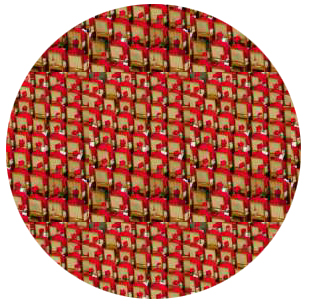
Personally, I like the Italian prospects, they seem to be the most endearing autocrats in the whole conclave. On-line bookies give the best odds to Dionigi Cardinal Tettamanzi, Archbishop of Milan. You look at his picture (photo #1) and think, what an old darling, vote him in. (He'll officially disapprove of us doing whatever we want, but I suspect we would still get away with it.)
The other Italian, a major long-shot, is Carlo Maria Cardinal Martini, retired Archbishop of Milan. (photo #2, surrounded by drinks that are not martinis). He speaks 11 languages and is in regular correspondence with Umberto Eco. There is one impediment though, he is a WILY COYOTE JESUIT (photo #3), and the moment his papacy is announced he'll go and start Vatican III.
Most people are under the illusion that the big Vatican councils produce reform, but they mostly produce documents to be ignored. (one of my favourites was written on the subject of the rhythm method, by a panel of laity, married men and women, several of them declaring that method of birth control to be unreliable and idiotic. They went on to speculate that if all the Bishops had to stick a cold thermometer up their butts every day ... I paraphrase, but these sentiments were actually expressed.)
What Vatican II did produce was the spectacle of Nuns, suddenly dressed in navy blue a-line skirts, white blouses and sensible shoes, playing 12 string guitars and singing Hava Nagila. A Vatican III could result in something even more weird and wonderful, with the added benefit of pissing off Cardinal Ratzinger, Mel Gibson and Mel Gibson's dad. That's probably a good enough reason for Digital Media Tree to offer all its all its moral, financial and political backing to endorse the candidacy of Carlo Maria Cardinal Martini, WILY COYOTE JESUIT (photo #3).
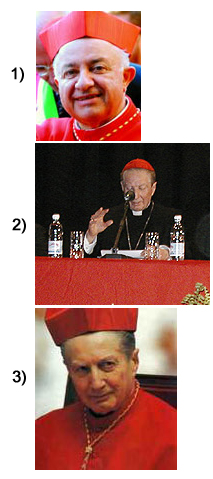
I just discovered that you find out the most obscure things when you google Fiddleback Chasuble Sightings. At this site, I learned that they were considered forbidden and reactionary in some circles. (Exactly who is in these circles, is unclear, also I don't know where I stand in relation to this controversy. I am not currently oppressed by this issue, but perhaps I will be in the future if I give it some more thought, and if so, a scathing indictment will follow on this blog. All I can say for the moment is that it just made me go all soft and squishy on them.) (but I could easily turn on a dime) Don't forget to check his link for the
wildly popular biretta sightings.

A further indictment of Maradiaga's prospective papacy is that he has been known to display a cavalier and blatant disregard for certain other Cardinals that he believes to be of little consequence.

Another very interesting candidate is Oscar Andrés Cardinal Rodríguez Maradiaga from the Honduras. According to the ADL's web site:
"The Anti-Defamation League (ADL) today expressed outrage at comments made by a Honduran Catholic Cardinal that implied an alleged Jewish manipulation of the American media. Cardinal Oscar Andres Rodriguez Maradiaga, in a May interview with the Italian-Catholic publication 30 Giorni, claimed Jews influenced the media to exploit the current controversy regarding sexual abuse by Catholic priests in order to divert attention from the Israeli-Palestinian crisis."
More on him from The Panama News.
Is he good for the Jews? I think not. (He's also bad for the children.)
b/t/w Bernard Francis Cardinal Law, former Archbishop of the Boston Archdiocese (former, because he wasn't good for the children either), is eligible to vote in the papal elections. But, he is not considered to be in the running because he is an American.

Next on our media favourites list is Francis Cardinal Arinze, the Nigerian Cardinal. A sweet old guy by all accounts. His African background sensitises him to the aids epidemic on that continent and he holds the belief that the church must immediately change its stand on condom use.
HA HA! JUST SCREWING WITH YOUR HEAD! Cardinal Ratzinger (who I am becoming quite obsessed with) is a major supporter his candidacy, so no condoms for you!

Image posted of behalf of L.M. What's that slogan?
UPDATE: L.M. says, "Putting the smackdown on heresy since 1981."
According to many news sources, Joseph Cardinal C, is considered a front runner in the upcoming papal elections. As you know, customary humility does not allow Cardinals to express any desire for this office or to openly promote their papal ambitions. Fortunately this particular Cardinal has a fan site: www.ratzingerfanclub.com and I think his web advocate does well in describing many of the reasons for his appeal.
Please note that the site does clarify the distinction between being a member of the Hitler Youth and actually joining the Nazi party.
Below is an excerpt from the new oath of secrecy, that the College of Cardinals now have to take before voting. It's from the vatican web site:
"Ego (positum appello) promitto qui, nisi acquiro precipuus licentio de novus electus pontiff, ego volo servo universitas perpetuus specialis per omnis externus ut Collegium Cardinalis electors inter omnis materia finitimus finitumus suffragium enim adopto per Pontifex Supremus.
Ego etiam promitto tempero usura ullus audioay vel ideovay apparatus idoneus perscribo quis secundum umquam per lectio ex Vatican civitas, pariter precipue quicquid finitimus finitumus lectio. Ego denuncio quod ego ingero iuro copiose infractio mos creo mihi infractio poena ideo posterus Pontifex Supremus mos censura, canonicus 1399 iussu principatus instituta apostolica."
...actually, it was posted in English, but I thought that Sally would prefer to see it in Latin. Unfortunately there wasn't a Latin translation for audio or video equipment so I had to use pig-Latin for those words. I was also a little unclear over whether I should write Pontifex Supremus, or directly translate to Supremus Pontifex. In the end, I chose to err on the side of pretension.
(there also wasn't a phrase translator on-line, so I did it word by word, I killed a lot of time and I was rewarded with a feeling of pomposity and smugness that I have never achieved with computer gaming)
You'll also notice that nothing is mentioned specifically about textus essagingmay from within the enclave, but most theologians will agree that this document (from 1996) would probably cover future developments in communication technologies.
Sally has anointed me as a papal election pundit, mostly because I am an educational product of the Sister Servants of Mary Immaculate. (making me a compliant and contented hen, of inoffensive and modest intelligence, blissfully resigned to my subservient status). Please do not respond to any of my postings with scriptural quotes, Catholics do not read the bible, so I won't know what the fuck you are talking about.
New guest poster L.M. coming soon...
 |
 |
 |
 |
 |
 |
 |
 |
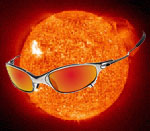 |
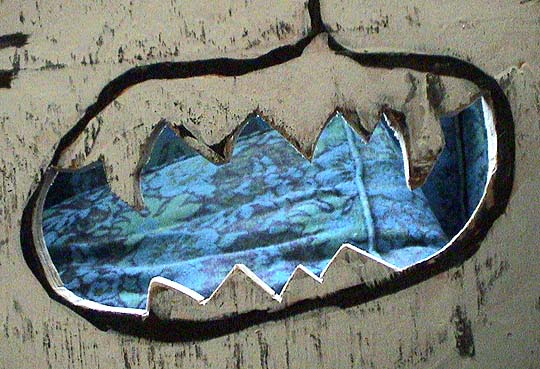
I am putting up art in Fly Gallery's window this coming weekend. The piece is tentatively titled "Qualia Street Party." There will be a combo opening party and Von Bark lecture later in April, details to be announced. In the meantime, if you happen to pass by 1172 Queen West next month, keep your eyes peeled for Fly, smack in between Queenglad pawnshop and the Saigon Flower restaurant.